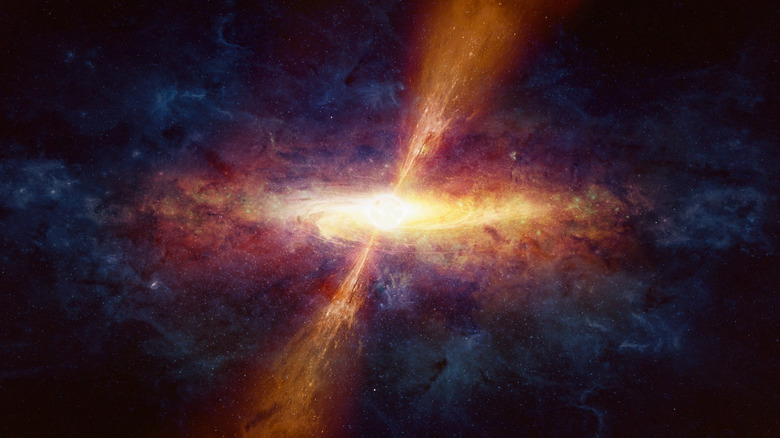The Biggest Known Structure In The Universe And How Far It Is From Earth
Our solar system is full of celestial wonders that we're still trying to understand, but there are even more marvels and phenomena throughout the universe. Earth may be huge to us, but it's only a tiny part of our Milky Way Galaxy, which is just a small part of the universe. In fact, the biggest structure in the universe that scientists know about is the Hercules-Corona Borealis Great Wall, and it's absolutely massive.
The Hercules-Corona Borealis Great Wall was discovered in 2013 by researchers in Hungary who were studying gamma-ray bursts. As far as scientists know, these phenomena are the most powerful in the universe and are short-term eruptions of light and energy, exploding with quintillion times the Sun's brightness. It's believed that gamma-ray bursts indicate locations of huge masses in space, and the Hungary-based astronomers discovered a particularly concentrated area of these eruptions near the Hercules and Corona Borealis constellations, which are about 10 billion light-years from Earth. Upon further investigation, they found this galactic filament, which is an enormous cluster of various types of galaxies, and it's 6 to 10 billion light-years long.
The Hercules–Corona Borealis Great Wall compared to other celestial bodies
While this galactic cluster is a magical wonder to say the least, researchers have found themselves a bit stumped because it goes against the principle of modern cosmology. One of the major proposals by Albert Einstein, this principle maintains that matter is distributed uniformly when viewed on a large scale and that structures can be no more than 1.2 billion light-years large. However, the Hercules-Corona Borealis Great Wall isn't uniform and completely breaks that scale.
To gain a better understanding of its size, it helps to know how the distance of light is calculated. In one second, light travels 186,000 miles, and in one year, it travels 5.88 trillion miles, which we refer to as 1 light-year. Since our Milky Way Galaxy is about 100,000 light-years across, you can calculate that it's 588,000 trillion miles across. Writing that out numerically is long and complex, and that's even more true if you were to write out the size of the Hercules–Corona Borealis Great Wall (10 billion light-years) in miles. That's one reason why we measure celestial distances in light-years.
However, our Milky Way isn't the only celestial body that pales in comparison to this astronomical wonder. It's part of the Laniakea Supercluster, which stretches more than 520 million light-years across. And, before the Hercules–Corona Borealis Great Wall was discovered, the largest known cosmic filament was the Sloan Great Wall at 1.3 billion light-years across.

